SHORT VERSION: The BUNN Heat N Brew makes awesome coffee. It does so by heating water to about 200° F before that water touches any coffee grounds, hence its SCA Certified Home Brewer status. But the water reservoir, unlike most other BUNN coffee makers, is not stainless steel. It’s plastic.
And yes, that means there is potential for this coffee maker to produce “plastic taste.” If this is enough to scare you off, you should read my research on the BUNN VP-17. But for some reason, plastic taste doesn’t affect everyone! If you’ve rarely-to-never experienced plastic taste from other coffee makers in the past, then I think there’s a good chance you’ll LOVE the BUNN Heat N Brew.
If you skim through a few articles on Buy/Don’t Buy, it won’t take long to figure out that I have a weird crush on BUNN coffee makers. While I mostly drool over the all-stainless-steel BUNN VP-17, I’ve also developed an admiration for BUNN products as a whole. They are one of the few companies in the coffee maker business that are pretty much All Coffee All The Time. That’s rare in today’s market. So does this mean that I’m automatically going to rave about BUNN’s relatively new SCA Certified coffee maker, the BUNN Heat N Brew? Well, there are definitely things to rave about, but there’s no doubt that the BUNN Heat N Brew has a few character flaws. Gotta “keep it 100,” as the kids say. I think that means “keep it honest.” Anyway, as always, we’ll take a look at both the good and the not-so-good.
Before diving into features and all that, I’d like to make note of a couple of things:
- Measure the space under your kitchen cabinets if you plan to put this coffee maker there. It needs about 20 inches of clearance with the reservoir lid open.
- You’ll notice that I’m referring to this coffee maker as “SCA Certified.” It’s not “SCAA Certified” because the SCAA is now called the SCA. Read my short article about that if you want to read some really lame coffee industry gossip.
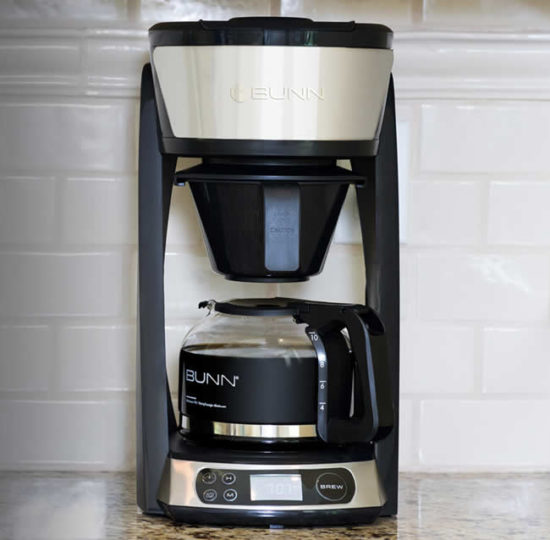
REASONS TO BUY
If you’re already familiar with BUNN coffee makers, then you will notice that the BUNN Heat N Brew is a departure from what they’re known for. BUNN’s Velocity Brew line, as well as their legendary VP-17, is built for speed. They keep water hot at all times and can pump out a full pot of coffee in just a few minutes. Many argue that keeping a tank of water heated 24/7 is a waste of electricity, and it kind of is, but fast brewing is a popular feature. Fast brewing is also why most BUNN coffee makers aren’t programmable. When they brew super fast, they don’t need to be! The BUNN Heat N Brew, however, is not a Velocity Brew model.
Unlike its fast-brewing cousins, the BUNN Heat N Brew is built to heat water on demand or when programmed to do so. Not only that, it won’t start brewing until the water reaches a temperature of about 200° F, right within SCA brewing standards of between 197° F to 205° F. According to BUNN, there’s a temperature-sensitive valve inside the water reservoir that won’t open until the water is hot enough. This means that brewing a full pot of coffee takes considerably longer than with a Velocity Brew or a VP-17. It also tends to take longer to brew than other coffee maker brands that do not adhere to SCA standards. Many of those non-SCA-Certified coffee makers, incidentally, produce coffee that is consistently underwhelming.
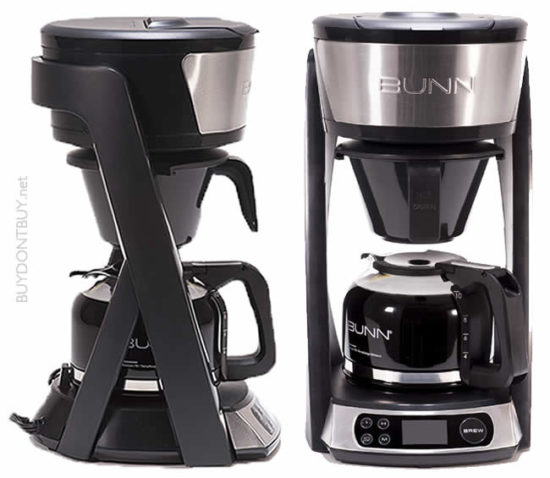
BUNN says it takes about six minutes to heat up a full tank of water, and an additional four minutes to brew. In all, you’re looking at about 10 minutes to get a full pot of 10 cups of coffee. This really isn’t so bad. The Behmor Brazen Plus (read review), which is also SCA Certified, takes roughly the same amount of time to brew 8 cups. Heating water takes time, and brewing great coffee requires water that is sufficiently hot.
If you’re impatient, the good news is that the BUNN Heat N Brew is programmable! Again, this is not a feature that BUNN is known for. But since this coffee maker is designed to brew on demand, rather than keeping water hot all the time, programmability is a must.
The BUNN Heat N Brew won’t start brewing until the water reaches a temperature of about 200° F, right within SCA brewing standards.
So how’s the Amazon feedback on BUNN’s SCA Certified coffee maker? Well, there really isn’t a ton of feedback on Amazon for this coffee maker as of yet. As of this writing, there are 28 total reviews on Amazon, and 21 of those are 4 star and 5 star reviews. This coffee maker is starting to gain fans, and here’s what some of those fans have been saying:
- Best coffee maker I have owned, and I have tried all of them! Not the fastest, but that is what makes the coffee quality so good. – Scottie J. Romero on April 1, 2018
- It takes a while longer to brew than your typical home coffee maker but it’s worth it. The water is heated to the proper temperature before brewing starts and the water is sprayed evenly over the grounds. I checked the water temperature with a digital thermometer and it comes in at a perfect 197 degrees. – LarryNC on July 31, 2018
- If you appreciate good coffee, go for this model. If you want fast coffee, stick with the k cup. – J Robert on February 24, 2018
- I’m in LOVE and I would recommend this to anyone, especially those who are looking for a machine to make coffee at the proper temperature (which is the whole reason I started looking into this machine to begin with). So far, the brewing temperature (measured with a thermometer in the grounds) was 201. – DCB on June 28, 2018
- Great coffee maker. SCAA certified to brew at optimal temperature. No problems in nearly a year of daily use. – Randall P. Sanders on August 5, 2018
What these reviews seem to indicate is that the heat-sensitive valve inside the water reservoir performs admirably. Water does, indeed, heat to the intended temperature of about 200° F, and that’s why it makes outstanding coffee. The reviews also tell us that owners of the BUNN Heat N Brew prefer to wait for great coffee. They know that this is part of the deal, and it doesn’t bother them one bit.

There are a few other things not fully addressed in the review snippets above. First, this coffee maker has a warming plate that shuts off after two hours. Nice. The carafe also has a no-drip design. Double nice. And perhaps most importantly, this coffee maker is proving to be pretty durable so far. One of the reviews above mentions “nearly a year of daily use.” And there are a few others who have mentioned roughly a year or more of regular usage. Getting one year out of a coffee maker isn’t exactly a record-breaking feat, but this model hasn’t been around for all that long. A lot of coffee maker reviews on Amazon are from people who just got their coffee maker yesterday. Given the small number of reviews on the BUNN Heat N Brew, it’s very promising to see that people are already reporting trouble-free usage for more than just a few weeks or months.
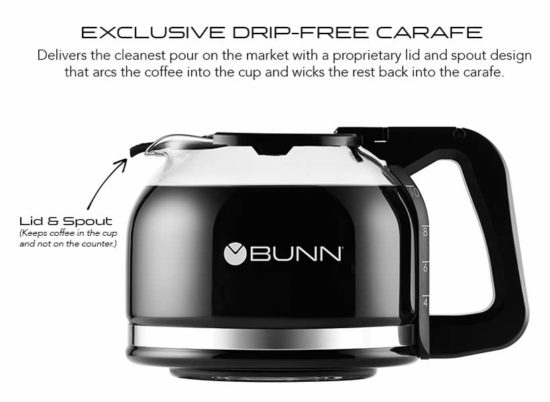
WATCH THIS VIDEO
Williams-Sonoma USED TO sell the BUNN Heat N Brew. They don’t anymore. But this video is still a good way to get a look at some of this coffee maker’s most important features.
REASONS TO NOT BUY
I have raved in the past about how the BUNN VP-17 is all stainless steel and therefore immune to the dreaded “plastic taste” that some coffee drinkers have dealt with. I have also made much ado about how BUNN’s Velocity Brew coffee makers are all equipped with stainless steel reservoirs. Again, no plastic taste. The BUNN Heat N Brew, however, does have a plastic water reservoir. Goshdarnit! Yes, the exterior of the water reservoir is shiny stainless steel, but it’s what inside the reservoir that you need to worry about.
Out of 7 negative reviews (3 stars or less), there is one very angry person who has written quite a lengthy review about getting a strong plastic taste and smell from this coffee maker. It is true that many buyers of Bunn Velocity Brew coffee makers have reported a plastic smell that went away with time, but this is new. Plastic taste in a BUNN coffee maker! I wish it weren’t true, but apparently it is. There is also one person who gave the BUNN Heat N Brew a positive 4-star rating because the plastic taste went away after a few days.

While it’s true that only TWO reviewers out of 28 have gotten plastic taste from their SCA Certified BUNN, it’s still a bit alarming. Also, this finding somewhat reinforces my theory that plastic water reservoirs are the culprit when the plastic taste demon rears its ugly head. The filter basket on this coffee maker is also made of plastic, but I still maintain that where the water heats up is what matters. Plastic bad, stainless steel good.
Aside from two people experiencing plastic taste, the other complaints about this BUNN Heat N Brew seem to be a bit scattered. A couple of people have mentioned that water sputters out of the top of the coffee maker. One of the people who commented on this actually gave the coffee maker a positive review because BUNN sent her a free low-flow spray head due to her home having soft water. Apparently that fixed the problem mostly, but not completely. Incidentally, this same complaint has been heard from buyers of the Behmor Brazen, whose form factor is similar to the BUNN Heat N Brew. It could be possible that this type of design might lend itself to some water-sputtering under certain conditions.
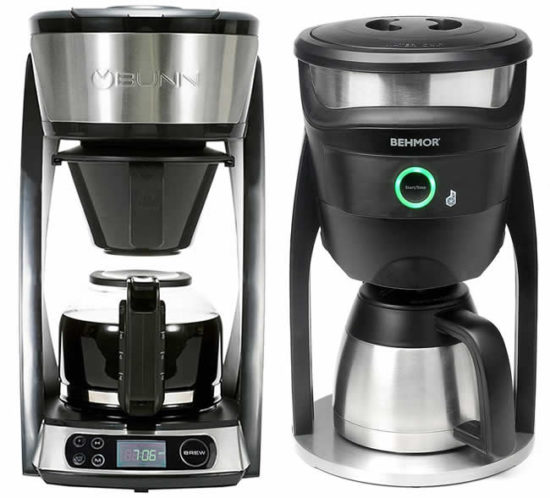
A couple of others have complained about the coffee maker failing to drip properly. I have no idea what the cause of this might be, but it’ll be interesting to see if others levy the same complaint in the future.
SUMMARY
Despite the relatively small amount of feedback on the BUNN Heat N Brew, Amazon users have actually taught us quite a bit about it. It earned its SCA Certified status for good reason—it brews at the right temperature, around 200° F. This coffee maker is also a bit slower to brew than you might be used to, but that’s intentional. BUNN calls this coffee maker the “Heat N Brew” for a reason! First it heats the water to the SCA-mandated temperature range. Then it brews. If you’re always in a rush and need your coffee fast, then you should probably be looking at a BUNN Velocity Brew or the BUNN VP-17.
The big disappointment with this coffee maker is that it is apparently NOT immune to plastic taste. The dreaded plastic taste curse has been reported by only 2 out of 28 reviewers (about 7%) so far, but it’s still a step in the wrong direction. BUNN, why didn’t you give this coffee maker a stainless steel reservoir??!!
If you have personally struggled with plastic taste in the past, I would skip the BUNN Heat N Brew and go directly for a BUNN VP-17. Pardon me for sounding like a broken record, but the VP-17 and it’s stainless steel construction is immune to plastic taste. And, as of right now, it seems that the BUNN Heat N Brew is not immune.

If the VP-17 is out of your price range and you haven’t had a problem with plastic taste in the past, then the BUNN Heat N Brew might work out for you. Provided you’re not in the (so far) small minority of plastic taste sufferers, this coffee maker is an outstanding buy. You get SCA Certified Home Brewer performance for a relatively low cost. And BUNN coffee makers, for the most part, have a very good reputation for longevity.
Based on the feedback so far, most people will not taste plastic. If you do, however, just send it back and check out these plastic-free coffee makers.
RECOMMENDATION
BUY IT if you’re not fazed by the plastic reservoir.
If plastic taste has been a chronic problem for you in the past, skip the Heat N Brew and read this right now.
[insert_php]
include ‘amazon_related_products_coffee.php’;
[/insert_php]

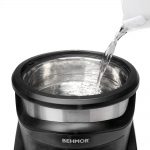
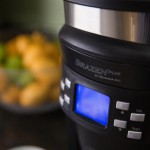


I have had a Bunn Velocity Brewer (internal stainless steel tank) or the past three years and have loved it. Great cup of coffee. When I saw the Programmable Bunn I ordered it and brewed my first cup of coffee this morning and was so excited until I took that first sip: YIKES plastic taste. I thought at first it might be the brew funnel but now after reading your post it has to be the plastic interior where the water is heated as I never got that taste from the plastic brew funnel of my other Bunn. I am so bummed!! Do people report that this “plastic taste” will go away? Help i may need to return it 🙁
It needs 20 inches of clearance between it and the cabinet above it when the reservoir is open? Good gravy, that’s nearly two feet! There’s barely that much space between my counter tops and the cabinets. Are you sure you got that right?